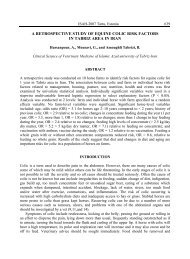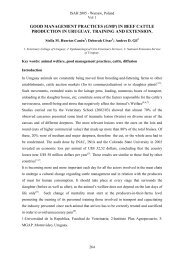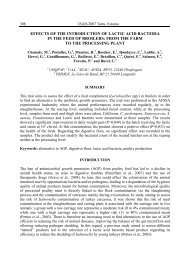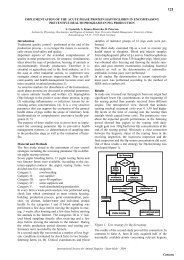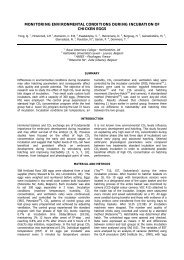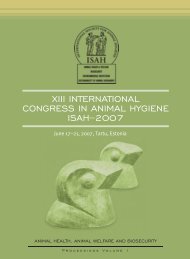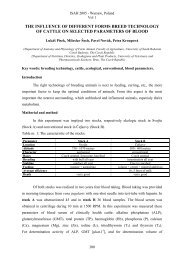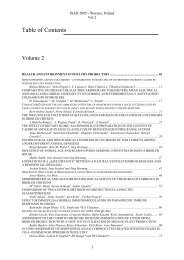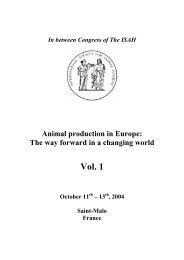IDENTIFICATION OF AIRBORNE FUNGI FROM ... - ISAH-SOC
IDENTIFICATION OF AIRBORNE FUNGI FROM ... - ISAH-SOC
IDENTIFICATION OF AIRBORNE FUNGI FROM ... - ISAH-SOC
You also want an ePaper? Increase the reach of your titles
YUMPU automatically turns print PDFs into web optimized ePapers that Google loves.
<strong>ISAH</strong>-2007 Tartu, Estonia 715<br />
2250(r1), 1750–1950(r2), 1550–1750(r3), 1350–1550(r4), 1150–1350(r5), 950–1150(r6), 850–<br />
950(r7), 750–850(r8), 650–750(r9), 550–650(r10), 450–550(r11), 350–450(r12), 250–350(r13),<br />
150–250(r14), 100(r15). The presence of a band within the above range was assigned a value ‘1’,<br />
while the absence of a band was assigned a value ‘0’. 91 isolates were tested with the five<br />
primers. 73 bands were obtained. A band pattern matrix was generated (data not shown here).<br />
2.5 Genetic Distance<br />
Isolates were clustered using UPGMA to calculate genetic distance. A dendrogram was generated<br />
from the distance matrix (Fig. 2). The distances among isolates are small. When threshold<br />
distance was set at 0.62, the 91 isolates were divided into 11 groups.<br />
3. DISCUSSION<br />
3.1 Plentiful diversity of aerosol fungi was found in the three tested chicken farms. The most<br />
frequent aerosol fungi are Aspergillus, some of which are opportunistic pathogens. For example,<br />
A. fumigatus and A. terreus were recorded to infect human and animals. Animal tests have shown<br />
that some Aspergillus species (e. g. A. flavus, A. parasiticus, A. versicolor) may produce<br />
aflatoxins that induce tumor or reduce white blood cells. The other frequent fungi in the farms<br />
include Penicillium, Alternaria, Acremonium and Fusarium. Some Penicillium species may<br />
clinically infect human beings who have been affected by leukaemia or lymphoma, or infect brain<br />
or lung and produce ochratoxins. Some Alternaria species may clinically cause skin infection<br />
such as hypersensitivity, pneumonitis or asthma. Some species of Alternaria may produce<br />
mycotoxins that induce oesophageal cancer. Acremonium may cause chromomycosis or<br />
phaeohyphomycosis. They commonly infect brain or skin. It is surprisingly found that Fusarium<br />
is a very common genus in these tested chicken houses. Fusarium species are very common in<br />
agricultural environment and some well-known for producing various mycotoxins. A few<br />
Fusarium species may induce skin or cornea ulcers, even in rare case being associated with cancer<br />
[12, 18–22] . The various fungal species may show certain virulence to the animals. It is necessary to<br />
further the study of their pathogenic ability to chickens.<br />
3.2 When threshold is set at 0.62, the tested Fusarium isolates can be differentiated into species<br />
that can be identified by morphological method. However, the five RAPD primers were unable to<br />
distinguish among F. moniliforme F. moniliforme var. subglutinans and F. moniliforme var.<br />
intermedium because of their close relationship. 75% isolates of the same species were clustered<br />
into the same group. Nearly 25% isolates were not clustered to groups in which they were<br />
supposed to be. This explains the variability of Fusarium species from molecular biology point of<br />
view. Some isolates (e.g. 27 and 28) are extremely close. They might belong to the same species<br />
of different isolates. The difference in collecting sites may result in different genetic distance of<br />
the same Fusarium species, such as Dalian isolate and Tai’an isolate of F. moniliforme. Its genetic<br />
distance between airborne isolates and isolates from wheat grains is relatively far-away,<br />
suggesting that the complicated environmental factors may cause variation of Fusarium species.<br />
This result is consistent with the instability of F. moniliforme [23] .<br />
F. graminearum did not produce conidia even cultured on SNA plate, which makes<br />
identification by morphology difficult. An isolate (No. 43) which is difficult identified did not<br />
form conidia on either PDA or PSA. Its purple pigment-producing colony indicates that it is



